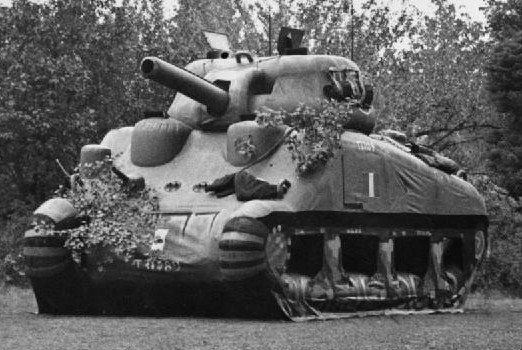During World War II, psychological warfare was an incredibly important, yet under-appreciated aspect of strategic combat that played an essential role in the Allied Powers’ victory. Whether it was used to misinform enemies with propaganda, or incite fear with inflatable vehicles and dummies, psychological warfare was used by both the Allied Powers and the Axis Alliance during World War II. In the modern day, psychological warfare is still used to intimidate; however overtime, methods and applications have evolved.
Christopher Cho explains.
An inflatable dummy tank based on the M4 Sherman tank.
One of the smartest tactics used by the allied forces were inflatable tanks and paradummies. Developed by a special task force known as, “The Ghost Army,” made up of the most intelligent soldiers and best artists, the Allied Powers utilized a variety of mediums to trick the Nazis, including, “inflatable tanks and vehicles, fake radio traffic, sound effects, even phony generals.” (Ghost Army) Because they were inflatable, these tanks were light enough to be carried by four men across a battlefield and gave the illusion of a much larger military presence. Paradummies, also known as Operation Titanic, were dolls used in place of real paratroopers in order to distract enemies and would often combust upon landing.
Planned by Ralph Ingersoll and Billy Harris and led by Colonel Harry L. Leeder, the Ghost Army and their devices gave the Allied Powers huge advantages during the war and would play a pivotal role in sowing key information for the D-Day invasion. To deceive Germany about the whereabouts of the invasion that would ultimately happen at Normandy, the Ghost Army placed inflatable tanks and military jeeps, where the battles were supposed to take place. Paradummies were dropped along with rifle simulators and SAS (Special Air Service) men to further deceive German soldiers.
The Allied forces had a lot of smart ways of using psychological warfare against their enemy. However, the Nazis and the Axis Powers also had their own forms of psychological warfare. The Axis Alliance were also quite successful when it came to their strategy in psychological warfare, but unlike the allies, they used propaganda as psychological warfare to further their ideological objectives, instead of trying to trick the enemy with fake soldiers and vehicles in order to win military battles. While the Allies tried weakening the Axis, the Axis convinced their soldiers to believe that the systematic extermination of many groups would restore order, using propaganda. Using the radio and other media outlets, Hitler had made the German population believe the Allies (mostly Great Britain and the United States of America) were under the control of Jewish people, creating nationwide antisemitism and justifying the murder of millions solely based on their identity.
Modern day
Though many psychological warfare strategies used during World War II were very successful, most of these strategies have become obsolete in modern day because of advancements in technology. For example, if a country tried to use inflatable tanks or paradummies, modern surveillance technology would easily detect a ruse. Modern day examples can be seen in the Russo-Ukraine war, during Russian protests. Whereas the radio allowed Nazi Germany to disseminate its propaganda in ways never imagined, social media allows the dissemination of propaganda and brings psychological warfare individualized directly to particular tastes. Social media propaganda could be used to make people believe whatever its creator wanted them to believe. Competing interests have simultaneously made citizens of Russia go against Putin and his need for war, but also have been used to further Russian objectives. Many citizens of Russia have started protests, which “... have emerged as the core of Russia’s antiwar movement. This effort includes hundreds of online communities and projects that have sprung up overnight to resist specific war-related government initiatives,” (Olimpieva) Consequently, there are reports of many Russian soldiers who didn't want to fight but were drafted and forced to. This is only one of many examples of psychological warfare being used in modern day, as Russian propaganda has had to work overtime to explain unexpected military losses and to stifle dissent at home.
D-Day was necessary for victory in World War II and the psychological tricks used were essential to the success of the mission. In contrast, the Nazis used their psychological warfare to further their ideological objectives and were also successful in doing this. As Russia continues to employ its psychological warfare to bolster propaganda for their war, the cost of that choice just might be paid in retreat, casualties and more propaganda to explain the failures of the Ukraine invasion to an increasingly sceptical Russian public.
What do you think of wartime counter-intelligence and psychological warfare? Let us know below.








